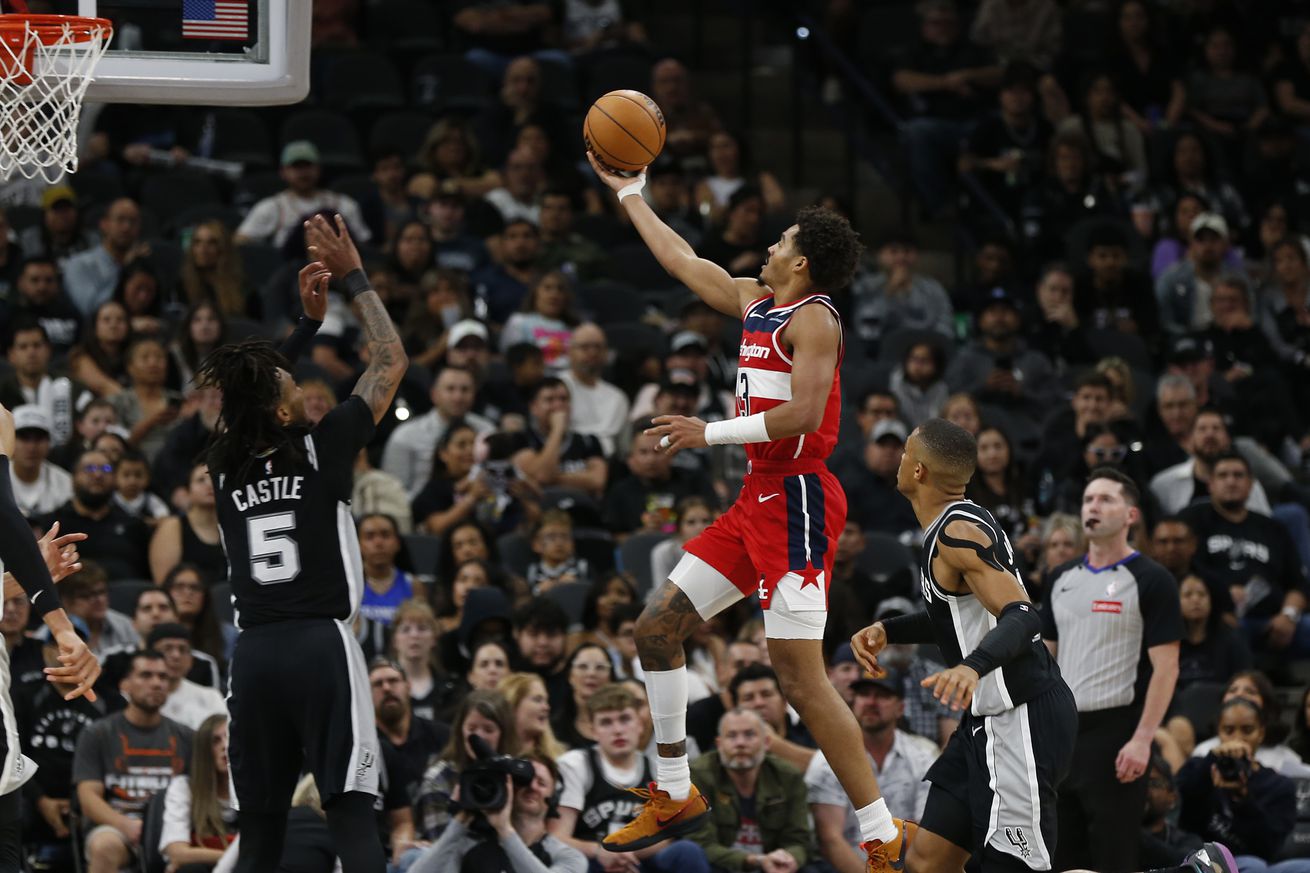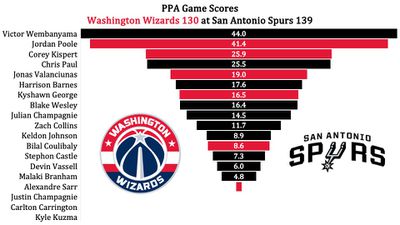
Stats, analysis, commentary.
Last night, the Washington Wizards had an effective field goal percentage of 61.1%, grabbed 11 offensive rebounds, and got a hyper-efficient 42 points from Jordan Poole, and lost, 139-130 to the San Antonio Spurs.
Could I nitpick the offense on the team’s best offensive performance of the season? Sure. But offense wasn’t the issue. Even with a few imperfections, the offense was more than good enough to win. They lost because they were helpless against Victor Wembanyama, and they couldn’t slow anyone else without fouling.
The 7-4 Frenchman poured in a career high 50 points, which included shooting 8-16 on threes, 10-13 on twos, and 6-9 from the free throw line. Wembanyama opened the game bombing threes. When Washington adjusted, he drove past slow-footed defenders for dunks. When they sent extra defenders, he still found ways to create good shots, and he converted. He added 6 rebounds, 2 assists, a steal and 3 blocks in an impressive, dominating performance.
For Washington, the story of the night was Poole’s shot making. He made an array of difficult shots en route to 42 points on just 22 field goal attempts — one point shy of his career high 43. Poole finished the night with 15-22 shooting, 6-9 from three, 6-6 from the free throw line. He added 6 assists and 2 steals. He also committed 3 turnovers and 5 fouls (though a couple of those fouls were of the “take foul” variety to stop the clock at the end of the game).
The Wizards trailed by as much as 21 points twice in the second half, including midway through the fourth quarter. Poole led the comeback with 15 points on 6-8 shooting and 2 assists, as well as timely three-point shooting from Corey Kispert (4-5 from deep in the fourth quarter).
The rally was enough to make the game close enough that Spurs fill-in head coach Mitch Johnson brought Wembanyama back into the game. It wasn’t enough to squeak out the win, however.
Johnson is filling in for long-time Spurs coach Gregg Popovich, who suffered what’s been publicly described as a “mild stroke.” The Spurs have said Popovich has already begun rehabilitation and is expected to make a full recovery. Hopefully, he can return to coaching soon, if that’s what he wants to do. At 75 years old, and with five NBA championships and an Olympic gold, Popovich has nothing more to prove or to cement his legacy as an all-time great coach.
Some positives:
- Kispert snapped out of his shooting slump, hitting 7-12 from the floor and 5-9 from three. He needs to make shots to have value.
- Valanciunas had another efficient night scoring and grabbed 13 rebounds (including 5 offensive boards). He also contributed a few stops on the defensive end. The big man ended the night with 16 points, 13 rebounds, 2 assists and 2 blocks.
- Kyshawn George had some exciting possessions as a playmaker, including one daring thread-the-needle bounce pass to a cutting Alex Sarr for a bucket. He finished with five assists to go with 12 points, 3 rebounds, and 2 steals.
- The Wizards opened the game with an interesting wrinkle to one of their standard sets. Typically, they initiate the offense by throwing the ball to a big in the key area. This time, Poole came up in the spot usually occupied by the center and became the distributor/hand-off hub. He handed off to Kuzma, who drove to the basket (and missed).
Some negatives:
- Bilal Coulibaly played a disappointingly passive game. Coulibaly attempted five shots in 38 minutes. The only player who attempted fewer last night was teammate Justin Champagnie who played 36 seconds. All of his Wizards teammates (except Champagnie) took more shots. Three Spurs matched his five field goal attempts — they played 30, 16 and 13 minutes respectively. He has too much ability to play 38 minutes with a 7.9% usage rate.
- Bub Carrington competed hard and committed two fouls to prevent Wembanyama highlight dunks. He also committed a whopping six turnovers. That makes the “negatives” list, though I’ll ultimately drop it into the “teachable moments” bucket.
- Kyle Kuzma had another bad game in his return from the groin injury. He had 10 points on 4-9 shooting (2-6 from three), 6 rebounds, and 6 turnovers. The turnovers were mainly sloppiness and inattention — a travel with poor footwork, bad passes, failing to notice a defender standing in his path and running him over. If he was a decade younger, we’d call them growing pains or teachable moments. At 29 years old and in his eighth season, he’s supposed to be teaching youngsters and setting an example.
By the way, at 39, and in his 20th NBA season, Chris Paul is still very good.
Four Factors
Below are the four factors that decide wins and losses in basketball — shooting (efg), rebounding (offensive rebounds), ball handling (turnovers), fouling (free throws made).
Stats & Metrics
Below are a few performance metrics, including the Player Production Average (PPA) Game Score. PPA is my overall production metric, which credits players for things they do that help a team win (scoring, rebounding, playmaking, defending) and dings them for things that hurt (missed shots, turnovers, bad defense, fouls).
Game Score (GmSC) converts individual production into points on the scoreboard. The scale is the same as points and reflects each player’s total contributions for the game. The lowest possible GmSC is zero.
PPA is a per possession metric designed for larger data sets. In small sample sizes, the numbers can get weird. In PPA, 100 is average, higher is better and replacement level is 45. For a single game, replacement level isn’t much use, and I reiterate the caution about small samples sometimes producing weird results.
POSS is the number of possessions each player was on the floor in this game.
ORTG = offensive rating, which is points produced per individual possessions x 100. League average last season was 114.8. Points produced is not the same as points scored. It includes the value of assists and offensive rebounds, as well as sharing credit when receiving an assist.
USG = offensive usage rate. Average is 20%.
ORTG and USG are versions of stats created by former Wizards assistant coach Dean Oliver and modified by me. ORTG is an efficiency measure that accounts for the value of shooting, offensive rebounds, assists and turnovers. USG includes shooting from the floor and free throw line, offensive rebounds, assists and turnovers.
+PTS = “Plus Points” is a measure of the points gained or lost by each player based on their efficiency in this game compared to league average efficiency on the same number of possessions. A player with an offensive rating (points produced per possession x 100) of 100 who uses 20 possessions would produce 20 points. If the league average efficiency is 114, the league — on average — would produced 22.8 points in the same 20 possessions. So, the player in this hypothetical would have a +PTS score of -2.8.

